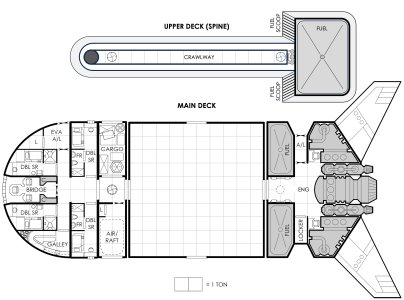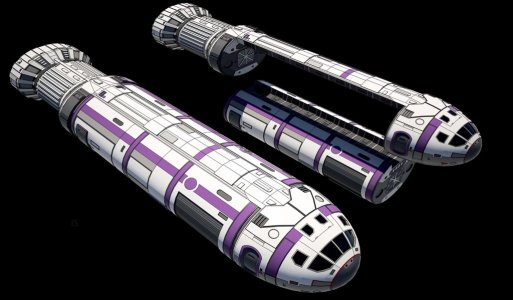Sageryne
Cosmic Mongoose

Hi all,
I have developed a new, 150-dTon Kestrel Class Modular Transport. It is suitable for 2 – 4-person crew (more if you share staterooms), perfect for a small adventuring party.
Kestrel Modular Transport.pdf
 drive.google.com
drive.google.com
I love developing starship deck plans. In a recent conversation on Reddit (r/Traveller), “If you were building a 6000dT star liner,” Geoff Stockham (username: gistockham) posted a link to some of his starship designs. He is using Robert Pearce’s Adventure Class Geomorphs like I am. I was particularly impressed with his Kestrel Class ship. He had several different variants depending on the task. I reached out to Geoff. We chatted and he gave me permission to expand upon his idea.
The result is a new modular ship. Inspired by the Eagle Transporter from Space: 1999, it has a bow section (like the command and service module) and a stern section (like the engineering module) connected by a truss or spine section. The key concept is the swappable center section. I kept with Geoff’s original class name. I made my ship 150-dTons, slightly bigger than Geoff’s (his was about 100-dTons), so it could use the standard 50-dTon quarter (or short) geomorphs for its replaceable module.
Thank you to Geoff for generously sharing his original idea. He made some great suggestions throughout the development process.
The first step was writing up the base ship. Originally, I only had four different versions based on Geoff’s designs (specific to IISS). That grew to 12 and then 24 variants. The linked PDF has a cover page with a description, perks and quirks, ships of the class (names), notable ships of the class, notes, adventure hooks, a Traveller News Service article, ship stats, deck plans, and interior descriptions. It is followed by six pages, each page with four different ship and module combinations with their own deck plans, module stats (including costs), and a brief module description. Finally, I created a large-scale map of the base model Kestrel suitable for tabletop play and another plan without a module for GMs to insert their own module into.
A big thanks to Robert Pearce, the creator of the amazing Adventure Class Starship Geomorphs. Be sure to check out his outstanding work at Yet Another Traveller Blog: https://travellerrpgblog.blogspot.com/
This PDF is intended to be printed out on 11” x 17” sized paper.
Enjoy
- Kerry
